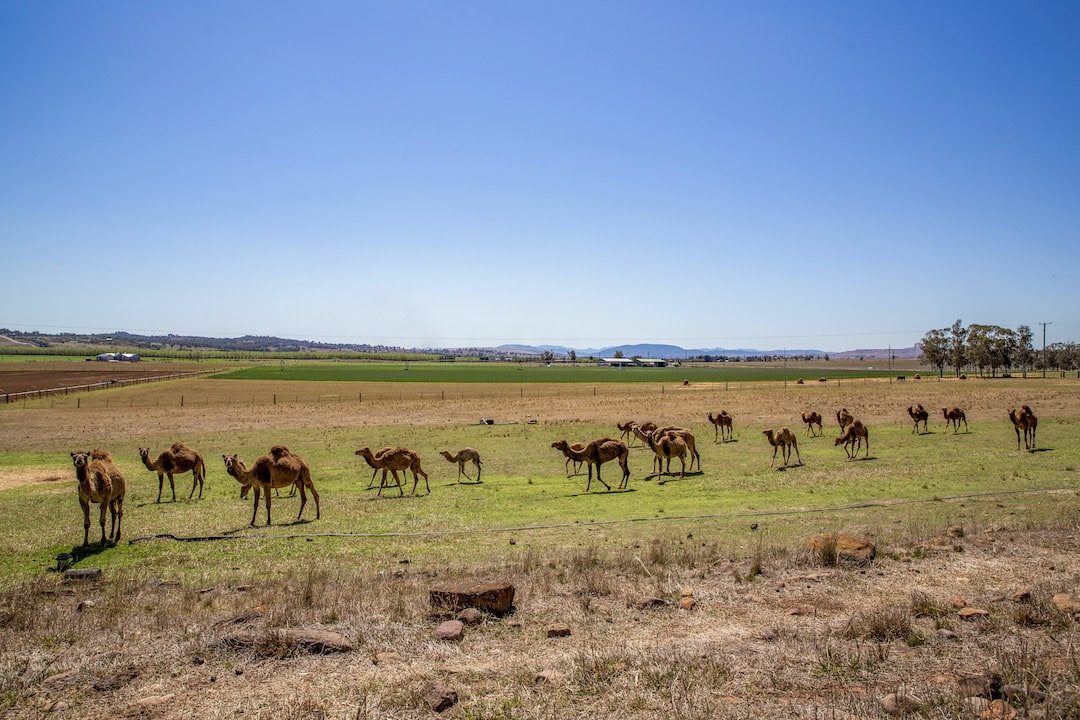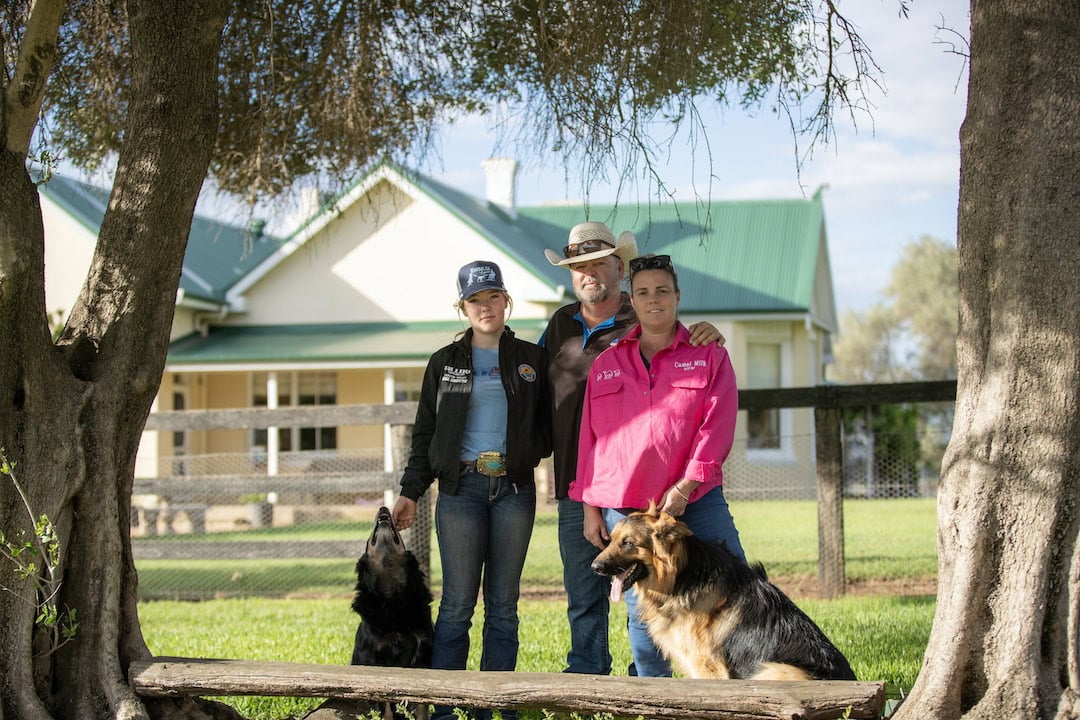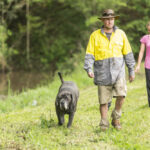Woolworths will end the 10 cents a litre drought levy in June that has supported…
An innovative camel milk journey

Hunter Valley farmer, Michelle Phillips and her husband Daniel have tapped into a huge resource of almost half a million ‘feral’ camels in the Aussie outback to produce fresh milk for a small but loyal market.
Their camel journey began in 2014, with a mission statement to produce their own camel milk.
“We started with five mothers and six babies from Western Australia. We picked them up at Shepparton before they got to the abattoir,” Michelle says.
“We’ve been rescuing more along the way to get the herd up to 50, which is about our capacity for this farm.”
“They are straight out of the bush, and it costs around $800 for a mature female these days.”

The caravan of camels share Michelle and Daniel’s 40-hectare Denman farm with horses and a small herd of Scottish Highland cattle.
Camels do have a reputation for being cranky, but Michelle says she has only seen their good side in nine years.
“People do say to me that they have heard camels are cantankerous, but I think that reputation comes from being chased around by four-wheel-drives in the desert.
“The camels we have here are fantastic to work with. We’ve got one stud bull named Huey, after Hugh Hefner, and he is a real sweetheart teddy bear. I was warned about getting a bull, but Huey has never been aggressive with anyone. He’s happy with his caravan of girls and has no one else to compete with.”
Huey’s ‘girls’ include Pamela (named after Pamela Anderson), Dolly (named after Dolly Parton) and Double D.
His calves are sold as ‘teenagers’ at three years old to fulfil various roles: to organic farms for weed control, as well as to petting zoos and lifestyle farms.
“It can take five to six years before a female is ready to breed, and then it’s a 13-month gestation period. So there are seven years of feeding before you get a return,” Michelle explains.
“We then have to leave the calves with their mothers, otherwise the milk production dries up.”

The cost to produce camel milk is significantly higher than cows. Camels produce a much lower yield of milk compared to a cow and you cannot milk a camel without sharing it with a calf for up to 18 months.
Michelle’s ‘girls’ are milked in the morning using a portable Show Milker in an existing set of cattle yards.
“We bring the camels into a shed at night and separate them, so the mothers have full udders of milk in the morning. They have four teats like a cow, and we just put the cups on while they are in a race.
“These are camels from the wild, not milking camels that have hundreds of years of selective breeding, so we do only get an average of four litres per camel per day.”
The milk is first stored in two vats on the Show Milker, then refrigerated, pasteurised and bottled on farm.
Michelle’s Camel Milk NSW business has won awards for its cheeses, but the focus these days is supplying fresh milk to retailers in Western Sydney.
“We’re doing everything ourselves. We bottle the milk, label it and then drive it to our resellers in Western Sydney once a week.”
Michelle sells 150 to 200 litres per week, mostly to IGA and Woolworths where it retails for up to $25 per litre.
“It does sound expensive, but it is on par compared to the much higher production you get with a dairy cow. And it does represent value when compared to other alternatives like almond milk, which retails for about three dollars per litre and is only about three per cent almonds, and the rest water.
“It can be a viable business for us at times. Like any farm business, it has its up and downs and it is very much a boutique product. No one else wants to deal with the small amount of production that we do.”

Running Camel Milk NSW is a full-time job for Michelle and part-time for Daniel, who also manufactures trailers on farm and does some local farm contracting. Camel Milk NSW also offers farm tours and a real ‘safari experience’, including meeting stud bull Huey.
Healthy properties
“It was a lifestyle choice for us, initially,” says Michelle. “I got into camel milk because one of my sons suffered from bad anxiety. I did not want to use the medication recommendations, so I started researching diets and came across the wonders of camel milk.
“There was only one dairy in Western Australia at the time, and I could not find anywhere to buy it on a regular basis. It was absolutely helping my son, so that’s why I started my own dairy.”
Michelle attributes the probiotics found in camel milk for the behavioural improvement in her son. She says most camel milk consumers are interested in its purported health benefits, including for people living with diabetes, autism and behavioural problems. It has been the core dairy foodstuff in Bedouin cultures for millennia, in which camel herders report surviving for weeks on camel milk alone.
One of the more definitive benefits is for patients with diabetes. Camel milk can contain up to 52 units of insulin per litre, and studies in India have shown that individuals with both Type 1 and Type 2 diabetes had significantly reduced blood sugar levels after two years of daily camel milk consumption.
Claims about the powers of camel milk in treating autism are mostly unsubstantiated, but anecdotal reports abound about its benefits for behavioural issues.

“It does have a great taste as well. It’s like cow’s milk, but a little thinner on the palate,” Michelle says.
“It’s great with Baileys. It froths really well and there are a few coffee shops now buying it to make Camelccinos.”
From the desert to Denman
Camels are hardy, but adapting these desert animals to the temperate climate of the Hunter Valley has presented a number of humps in Michelle’s camel adventure.
The first is the need to satisfy a love of variety in their diet, including browsing on trees. One of Michelle’s farm routines is trimming tree branches on the property to produce fresh flushes of vegetation for the camels.
“They love to eat a wide variety of vegetation, from lucerne and clover right through to the thorniest of bushes that you can imagine. They enjoy bark, twigs and branches and do love to munch on wattle trees.”
Michelle and Daniel produce hay from lucerne and oat crops, and the camels also graze on improved pastures.
“Camels do not naturally graze on lucerne and oats of course, but they seem happy to have it added to their diet here,” says Michelle.
“We do have to provide them with a lot of minerals and salts that were naturally available to them from evaporating lakes in central Australia. Camels can’t lick, so the minerals are provided as a loose mix and they eat bags of pool salt like it’s going out of fashion.”
Michelle says combating worms has been the biggest challenge.
“There are no worms in the desert. The camels come from the desert super healthy and start grazing on some grasses here, and they don’t have the same tolerance to worms like horses and cattle.
“Worm management is something we monitor closely. There are only five different drenches we can use, and we must avoid any form of resistance to these drenches over the camel’s lifespan, which can be up to 40 years.
“I know my camels pretty well now, and I know that worms have a party when the weather warms up and after it rains.
“Other than the worms, they are bombproof. You don’t have to work on their feet because they do have hooves and do not suffer from bloat.”

Michelle also says the camels provide a dose of health benefits for other animals on the farm, particularly the Scottish Highland cattle.
“They are good companion animals to have on the farm. One reason is because of the bacteria in their saliva, which they transfer to the water troughs when they drink, and the cattle consume them when they have a drink. These bacteria then improve the conversion of grasses to weight gain in the cattle.
“We first noticed this when our livestock agents in Scone were questioning why our steers were getting so heavy in such a short time.
“We had been told by our mates within the camel industry that they are good to run with other animals, but were not aware of this benefit until our agents realised we had camels and they said that’s the reason why.”
The experience of Michelle’s livestock agents is backed by a University of Queensland study completed in 2014 which found that microorganisms present in camels do indeed improve the digestive system in cattle. Conducted in Richmond in North Queensland, the study discovered that cattle that were co-grazed with camels had a better ability to digest low-quality tropical grasses like Mitchell Grass.
To read about other creative farming businesses in NSW, click here.








